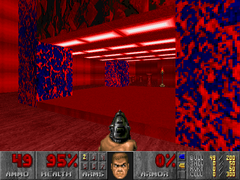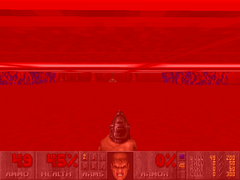m (link fix) |
No edit summary |
||
| Line 8: | Line 8: | ||
Crushing ceilings are set in motion by specific [[linedef types]]. Once started, they remain running for the remainder of the level, even if temporarily suspended with a "stop" linedef type. Some or all other actions in the sector may be locked out thereafter (depending on the [[source port]] used for play). A stopped crusher can be restarted, but not changed, with any crusher "start" linedef. |
Crushing ceilings are set in motion by specific [[linedef types]]. Once started, they remain running for the remainder of the level, even if temporarily suspended with a "stop" linedef type. Some or all other actions in the sector may be locked out thereafter (depending on the [[source port]] used for play). A stopped crusher can be restarted, but not changed, with any crusher "start" linedef. |
||
| − | A crusher can be either slow or fast. A slow crusher does more damage, simply by being applied longer. When a slow crusher is moving down and |
+ | A crusher can be either slow or fast. A slow crusher does more damage, simply by being applied longer. When a slow crusher is moving down and hits a player or monster, it slows down even more, by a factor of eight. This persists until it reaches the bottom of its stroke and starts upward again. Fast crushers do not slow down. |
A crusher does 10 [[hit point]]s of damage every 4/35 of a second, equivalent to 87.5 HP per second. |
A crusher does 10 [[hit point]]s of damage every 4/35 of a second, equivalent to 87.5 HP per second. |
||
Revision as of 18:15, 14 February 2009

Crusher in Doom E2M4

Caught in the crusher, Doom E2M4. Ouch.
Crushing ceilings appear in Doom, Heretic, and Hexen.
A crushing ceiling cycles between its starting height and eight units above its sector's floor. It damages any player or monster that happens to be in between. In Doom, barrels explode when crushed, corpses become pools of blood, and weapons and clips dropped by zombies disappear. (Ghost monsters and their corpses are unaffected.) Crushing ceilings also destroy projectiles, whether fired by the player or by monsters.
Crushing ceilings are set in motion by specific linedef types. Once started, they remain running for the remainder of the level, even if temporarily suspended with a "stop" linedef type. Some or all other actions in the sector may be locked out thereafter (depending on the source port used for play). A stopped crusher can be restarted, but not changed, with any crusher "start" linedef.
A crusher can be either slow or fast. A slow crusher does more damage, simply by being applied longer. When a slow crusher is moving down and hits a player or monster, it slows down even more, by a factor of eight. This persists until it reaches the bottom of its stroke and starts upward again. Fast crushers do not slow down.
A crusher does 10 hit points of damage every 4/35 of a second, equivalent to 87.5 HP per second.
Crushing ceilings are listed as part of the "dangerous Doom environment" in the printed game booklets.
Certain types of rising floors can also inflict crush damage: see Varieties of floors.
The Boom source port defines additional varieties of crushers: see Crusher ceilings.
Source
- Boom source code: boomref.txt
